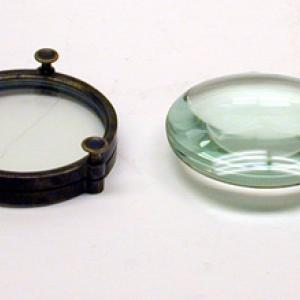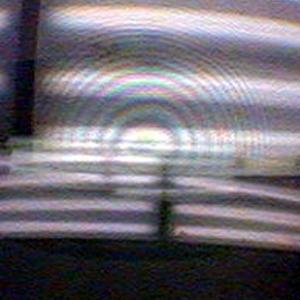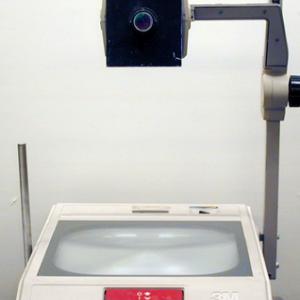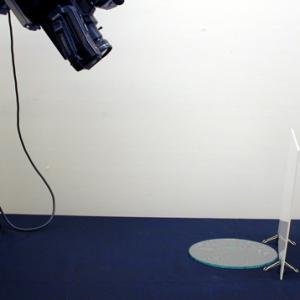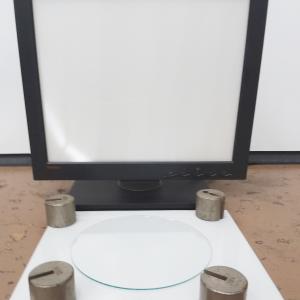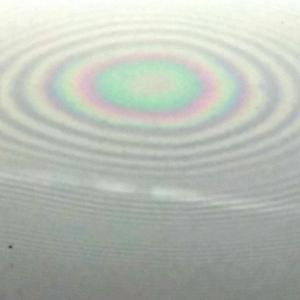College of Liberal Arts & Sciences
6D30.10 - Thin Film Interference - Newton's Rings
The Newton's Ring unit (Brass) is the traditional way Newton's rings are produced. This unit may be passed around in class if desired.
The overhead Newton's ring unit must be placed in the light path between the overhead projector and the screen. If it is placed on the overhead projector in the normal fashion no rings will be observed.
An easier and better way to show Newton's rings is to use the two round plates in the same manner as before. However instead of illuminating with a sodium lamp we use a standard fluorescent light. You must be looking at the reflection of the fluorescent light in the round plates. The Newton's rings produced can be easily seen when projected with the aid of a video camera.
The red filter may be added to the camera to view a fairly monochromatic pattern.
A very large Newton's ring may be made by putting a dime in the middle and under the large white Plexiglas plate. Place the large glass plate onto the white plate and a large Newton's ring pattern should appear when looking at the reflected light of the monitor. It may be necessary to bend the Plexiglass plate by placing the 500 gram masses at the corners. You can also move them to other places on the plate to create a larger or more round ring pattern.
NOTE: Optical flat in this box is also used for 6D30.35.
- Ronald Newburgh, "Author's Correction: 'Student Difficulties in Analyzing Thin-Film Interference,' Phys. Teach. 47, 227–230 (April 2009)", TPT, Vol. 47, #6, Sept. 2009, p. 328.
- Ronald Newburgh and Douglass Goodale, "Student Difficulties in Analyzing Thin-Film Interference", TPT, Vol. 47, #4, Apr. 2009, p. 227.
- Vincent Mallette, "Brilliant Newton's Rings [Phys. Teach. 9(3), 153 (1971)]", TPT, Vol. 41, #3, Mar. 2003, p. 186.
- Benjamin S. Perkalskis and J. Reuben Freeman, "Herschel's Interference Demonstration", TPT, Vol. 38, #3, Mar. 2000, p. 142.
- Kai‐yin Cheung and Se‐yuen Mak, "Giant Newton's Rings", TPT, Vol. 34, #1, Jan. 1996, p. 35.
- G. R. Davies, "Interference and Diffraction Corridor Demonstrations", TPT, Vol. 33, #4, Apr. 1995, p. 244.
- James Huhn, "Cheap Interference", TPT, Vol. 34, #1, Jan. 1996, p. 5.
- John Moreland, "Squeezable Junctions for Electron Tunneling and Surface Electric Field Experiment", TPT, Vol. 24, #7, Oct. 1986, p. 405.
- Jim Nelson, Adlai Waxman, and James Trefil, "Thick Film Interference", TPT, Vol. 21, #2, Feb. 1983, p. 119.
- Y. P. Hwu, "Interference Rings by Multiple Internal Reflections", TPT, Vol. 18, #7, Oct. 1980, p. 531.
- Frank A. Anderson, "In Reply...", TPT, Vol. 11, #6, Sept. 1973, p. 327.
- Mario Iona, "Very Special Cases", TPT, Vol. 11, #6, Sept. 1973, p. 326.
- Frank A. Anderson, "Drawing Wave Diagrams for the Interference of Light", TPT, Vol. 11, #3, Mar. 1973, p. 175.
- Syed Ziauddin, "Newton's Rings", TPT, Vol. 10, #8, Nov. 1972, p. 477.
- Fr. Earl R. Meyer, "Recording Timer Tape for Interference Demonstrations", TPT, Vol. 10, #6, Sept. 1972, p. 334, also A Potpourri of Physics Teaching Ideas - Optics and Waves, p. 202.
- James Moore, "Viewing Diffraction Fringes", TPT, Vol. 9, #3, Mar. 1971, p. 153.
- Vincent Mallette, "Brilliant Newton's Rings", TPT, Vol. 9, #3, Mar. 1971, p. 153.
- Leslie J. Atkins and Richard C. Elliott, "Investigating Thin Film Interference With a Digital Camera", AJP, Vol. 78, #12, Dec. 2010, p. 1248.
- Javier Hernández-Andrés, Eva M. Valero, Juan L. Nieves, and Javier Romero, "Fizeau Fringes at Home", AJP, Vol. 70, #7, July 2002, p. 684.
- Michael Belsley, "Comment on 'Newton's Rings: A Classroom Demonstration with a He-Ne Laser,' by A. F. Leung and Jiyeon Ester Lee [Am. J. Phys. 59, 662-664 (1991)]", AJP, Vol. 60, #11, Nov. 1992, p. 1044.
- A. F. Leung and Jiyeon Ester Lee, "Newton's Rings: A Classroom Demonstration with a He-Ne Laser", AJP, Vol. 59, #7, July 1991, p. 662.
- D. G. Sargood, "On the Use of Float Glass in Lecture Demonstration Experiments in Optics", AJP, Vol. 46, #2, Feb. 1978, p. 187.
- Eugene Hecht, "Interference Fringes in a Flowing Liquid Film", AJP, Vol. 43, #2, Feb. 1975, p. 187.
- Michael J. Moloney, "Laser-Lens Demonstration of Interference Rings", AJP, Vol. 42, #5, May 1974, p. 411.
- H. S. Sandhu and G. B. Friedmann, "Determination of Radii of Curvature of Spherical Surfaces using Newton's Rings", AJP, Vol. 33, #10, Oct. 1965, p. 818.
- "O-460. Newton's Rings Between Glass", DICK and RAE Physics Demo Notebook, 1993.
- G. D. Freier and F. J. Anderson, "Ol-17", A Demonstration Handbook for Physics.
- Richard Manliffe Sutton, "L-71", Demonstration Experiments in Physics.
- Wallace A. Hilton, "I-11", Experiments in Optical Physics, p. 37.
- George M. Hopkins, "Microscopical Examination of the Phenomenon of Colors of Thin Plates", Experimental Science, p 301.
- John Henry Pepper, "The Interference of Light", Cyclopadic Science Simplified, p. 109.
- John Henry Pepper, "Colours of thin Plates", Cyclopadic Science Simplified, p. 106.
- T. Kallard, "Newton's Rings Demonstration", Exploring Laser Light, p. 126.
- Bill Franklin, "Understanding Interference Colors", Teaching about Color & Color Vision, 1996, p. 2C-13.
- Pat Murphy, Ellen Macaulay, and the staff of the Exploratorium, "Soap-Film Stars", Exploratopia, p. 310.
- Yaakov Kraftmakher, "4.1. Interference of Light", Experiments and Demonstrations in Physics, ISBN 981-256-602-3, p. 221.
- James Cunningham and Norman Herr, "7.3. Interference and Diffraction", Hands-On Physics Activities, p. 467.
- C. Harvey Palmer, "Experiment B8: Demonstration of Fizeau and Haidinger Bands", Optics - Experiments and Demonstrations, John Hopkins Press, 1962.
- "26. Newton's Experiment on Interference", Experiments in Optics, Part 1, J. Klinger Scientific Apparatus Corp., Bulletin 101.
- T. D. Rossing and C. J. Chiaverina, "1. Thin Film Interference With Soap Bubbles", Light Science, Physics and Visual Arts, p. 124.
- T. D. Rossing and C. J. Chiaverina, "5.3. Interference In Thin Films", Light Science, Physics and Visual Arts, p. 108.
- Joseph Frick, "#189 - Newton's Rings", Physical Technics: Or Practical Instructions for Making Experiments in Physics and the Construction of Physical Apparatus with the Most Limmited Means, p. 219.
Disclaimer: These demonstrations are provided only for illustrative use by persons affiliated with The University of Iowa and only under the direction of a trained instructor or physicist. The University of Iowa is not responsible for demonstrations performed by those using their own equipment or who choose to use this reference material for their own purpose. The demonstrations included here are within the public domain and can be found in materials contained in libraries, bookstores, and through electronic sources. Performing all or any portion of any of these demonstrations, with or without revisions not depicted here entails inherent risks. These risks include, without limitation, bodily injury (and possibly death), including risks to health that may be temporary or permanent and that may exacerbate a pre-existing medical condition; and property loss or damage. Anyone performing any part of these demonstrations, even with revisions, knowingly and voluntarily assumes all risks associated with them.
